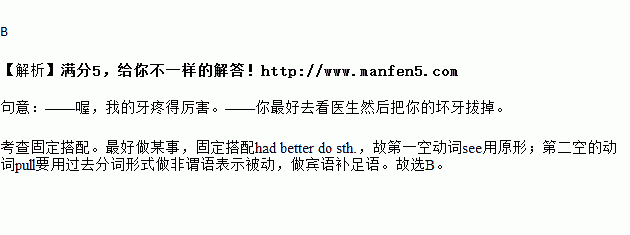题目内容
—Oh, I had a terrible toothache.
—You’d better _____ a doctor and have your bad tooth _____ out.
A.to see; pulling B.see; pulled C.seeing; pulled
Having breakfast | Drinking milk | Going to bed | Eating fruit | |
Common time | From 6:30 to 7:00 | During breakfast time | About 22:30 | After meals |
Right time | About 7:00,twenty minutes after getting up | Before sleeping | Around 21:00 | An hour before meals |
Benefit | 1 or 2 eggs will provide you with essential proteins(蛋白质) to begin your day. | Milk can help your bones become strong. Milk also helps you sleep better. | The right time of sleep can help you get a deep sleep. | It’s great to start your day with fresh fruit. Fruit can keep your body strong and make your face better. |
Other things | Quit junk food and eat some healthy food. | You can make fruit salad with some milk. | Have enough sleep, at least eight hours a night. | Clean fruit carefully before you eat it. |
1.Teenagers usually have their breakfast ________according to the chart .
A.from 6:00 to 7:00 B.from 6:30 to 7:00 C.twenty minutes after getting up
2.From the chart we know that teenagers often go to bed ________ later than the right time
A.one hour B.one and a half hours C.two hours
3.Which of the following is TRUE according to the chart?
A.Milk can keep your body strong and make your face better.
B.If you eat eggs for your breakfast, you can get essential proteins.
C.If you sleep later than the right time, you will get a deep sleep.






